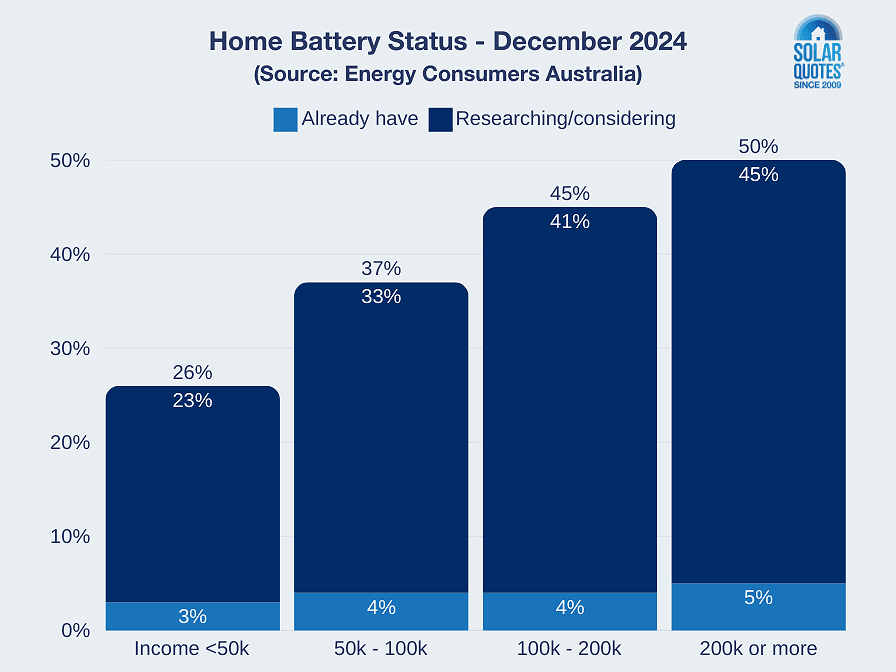A recent survey suggests many Australian households have low energy literacy, and a majority want simplicity in their relationships with electricity retailers.
Energy Consumers Australia’s December 2024 Consumer Energy Report Card quizzed 4,152 households across Australia on their electricity plan knowledge and found while the vast majority were confident they knew who their energy company was and even the network supplying their home:
- 18% didn’t know the unit of measurement used on their electricity bills (kilowatt-hour/KWh).
- 37% didn’t know type of retail tariff they are on (e.g. flat rate, Time of Use/ToU).
- 37% didn’t know what a retail tariff was.
Electricity Plans And The KISS Principle
54% of households said they just wanted a “basic” relationship with the energy system. This entailed getting a good price for electricity consumed (and exported in the case of solar energy), having a reliable electricity supply and good customer service from a retailer.
But 46% wanted more choice, control, or flexibility over how they manage their electricity. The survey found those wanting an “active relationship” were more likely solar and higher income households.
Whether you have solar panels or not, if you’re looking for an easy way to run comparisons on electricity retailers, you can compare electricity plans right here on SQ.
Time-Of-Use And Demand Tariffs
More than 30% of households said they were on a time-of-use or demand tariff and only one in three of that group chose to be on it. Lower income households were less likely to have chosen to be on such an electricity plan.
Time of use tariffs, as the name suggests, feature varying pricing for different time periods – and the difference in rates can be huge. On my current plan; the shoulder rate (10am – 3pm) is 16.78 c/kWh after a 7% discount. The peak rate (3pm – midnight and 6am to 9am) is 56.98c; again after discounts.
The other type – demand tariffs – can deliver nasty surprises. Plans with demand tariffs may offer lower consumption charges, but penalise customers if they exceed a threshold for *power*1 demand through the concurrent use of power-hungry appliances. And this may only need to happen once and briefly before demand charges are applied over a month or full billing period.
While 34% of households on a time-of-use or demand tariff said they regularly change when appliances are used to save money, 30% indicated they don’t at all; or rarely.
But looking at *how* those who adapt go about it, households tended to vary use on less energy-intensive appliances (e.g. washing machines and dishwashers) rather than the heavy hitters such as air-conditioning and heating. But it can be challenging to time-shift those applications as their use depends on when they are actually needed; often in the mornings and late afternoons/evenings when peak rates apply. Although there’s a case for pre-heating and cooling during cheaper time periods for a thermally efficient home, many Australian homes aren’t.
Another activity not time-shifted as much was water heating. An electric water heater could be set on a timer, or if a household has solar panels; something like a PV diverter or Catch Control (which can also do much more) can be used.
Home Batteries On Many Wishlists
As for Australians indicating they are currently researching or considering options to buy a home battery system, 23% of households with an annual income of under $50,000 said they were. The proportion climbed as household income did – topping out at 45% where income was $200,000 or more.
For those in the battery research phase, you’re in the right place. SolarQuotes’ comprehensive home battery guide will tell you everything you need to know in plain English, or you can focus on specific areas – understanding, buying or owning solar batteries.
Energy Consumers Australia’s December 2024 Consumer Energy Report Card can be viewed in full here.
Footnotes
- Learn about the difference between power and energy here. ↩



 RSS - Posts
RSS - Posts



Govs should ban Demand Tariffs for retail customer, Time of Use is fine but no-one understands Demand Tariffs and it’s causing a blowback.
Thankfully here in Vic it’s already not allowed..
Looking at the report I wonder if the phrasing of the questions had any impact on the answers?
Do people talk about their “home energy retail company” or do they talk about their electricity company? A home energy retail company could be your gas supplier!
Similarly, do people use the phrase “energy network company that supplies energy to your house”? Or do they talk about their (electricity) distributer, the poles and wires company, or simply say Ausgrid, Energex, Powercor, TasNetworks etc?
Do people talk about a retail tariff or a usage tariff? Might not a retail tariff refer to a daily tariff i.e. connection fee? Different companies, and\or states, use different terminology.
In short, if the questions are based on the terminology used exclusively by one company, one state, or one element of society, it’s possible the results are skewed. Or am I seeing a possible issue where there is none?
Did the survey also like potential EV users – would be interesting to know if they also asked about V2H with EVs as a battery option.
Not as I recall but you can find the report here (https://energyconsumersaustralia.com.au/publications/consumer-energy-report-card) if you’re interested.
OK, thank you, it looks like the report excluded considering EVs:
“Due to the current low rate of EV ownership, EV charging was not included in this analysis but will be monitored in the future. As EV charging represents a significant household load, the ability to schedule charging during off-peak times makes time-of-use tariffs likely to be financially attractive for EV owners. ”
I imagine by next time that EVs might be included then V2H/V2G might be a bit more on the radar.
In a country where literacy itself is deficient (“energy literacy” – does energy read and write?), a lack of understanding of energy, and, of terms associated with energy and electricity, and, of how to deal with electricity, is not surprising.
This is Australia.
Energy is generally taken to mean whether a person feels inclined to get off the couch and to walk to the fridge, to get another can of beer (having the energy to do it), or, simply cannot be bothered, due to some idiotic television program being broadcast (not having the energy to do it).
Perhaps, if reading and writing and arithmetic, and, basic, classical science, including basic classical physics, would be taught as part of mandatory education, then, perhaps, sufficient of the populace might understand why a BEV “granny charger”, an electric jug, a hairdryer and a toaster, should not be run off the same power point, through a series of double adaptors, at the same time, or, why, in a fuse board with a 10A fuse, that does not mean using number 10 fencing wire, or, a 10 gauge nail, to replace the fuse wire (“well, they all have the number 10, so, it must be okay”).
Academia includes a wide variety of literacies e.g. carbon literacy, digital literacy, faith literacy, health literacy, information literacy, physical literacy, scientific literacy. Reading and writing may or may not have any connection to such prefixed literacy types.
I thought reading, writing, arithmetic, and science was still part of mandatory education. Is it that my days of schooling are far too far behind me, or my schooling and\or teachers were super special? I mean I know some of them absolutely went the extra mile for us students, but surely the basics are still the basics no? Why would BEVs, granny chargers, or power points be discussed in classes? PowerPoint might be, but that’s a completely different matter!
Barring a TAFE course or an electrical engineering degree, how often would fuse boards or amps even be covered in school? Physics maybe, but probably not based on what I recall.